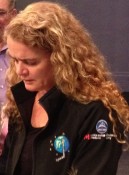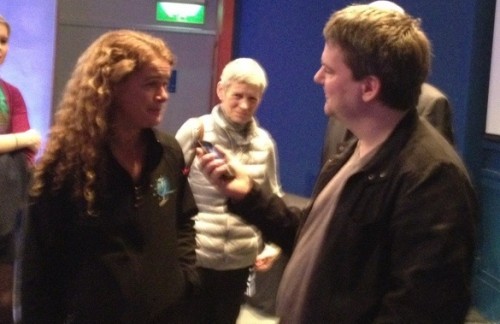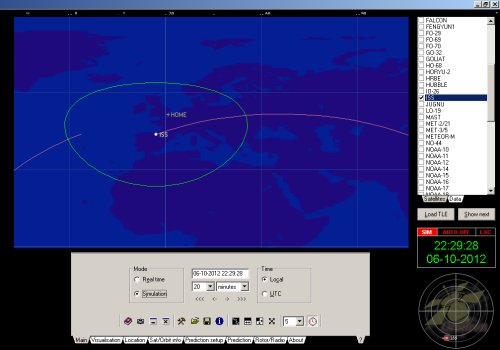Most of the astronauts above the International Space Station are licensed amateur radio operators, and aboard the ISS is a ham radio station. During the crew’s off-hours, they’ll occasionally use the radio to chat to other hams 250-or-so miles below them. They also take part in various educational amateur radio exchanges (a scheme known as ARISS)
Although I’ve not had any luck making voice contact with the International Space Station, I’ve received several voice contacts from the ISS, and made contact via data, Talking to an astronaut is still something that I’d love to do, and it’s high on my “ham radio to-do list”.
 My aim of making a contact with NA1SS, the callsign for the International Space Station, moved higher up the list, following a chance encounter with the truly lovely Julie Payette a while back.
My aim of making a contact with NA1SS, the callsign for the International Space Station, moved higher up the list, following a chance encounter with the truly lovely Julie Payette a while back.
Julie is an astronaut for the Canadian Space Agency, and has flown on two Space Shuttle missions (STS-96 and STS-127). She’s spent a total of 25 days in space, and has had two stays aboard the ISS. Although she didn’t operate from the space station’s ham equipment whilst on the station, she’s keen to encourage any ham operators out there to give it a go.
After talking to a keen group of budding scientists at London’s Science Museum in October 2011, Julie very kindly took the time to answer a quick question about ham radio from the space station, and to offer words of encouragement to those looking to try to make contact. You can hear her comments on a short podcast that I’ve just put together discussing amateur radio operations aboard the space station.
|
Play Essex Ham Podcast: Working the ISS (5 min, mp3 format)
|

Thanks to Julie Payette from the CSA for taking the time to talk to me, and to fire up my desire to make that first contact with the ISS.
How to contact the ISS
Contacting the International Space Station is technically within every amateur’s reach. Foundation licence holders have successfully made contact, and this can be done with modest power (5 to 10 watts) with modest antennas. You’ll need a 2 metre radio to make the contact, and a lot of patience.
The first thing you need to realise, is that the ISS only in line-of-sight for a short window. It orbits the earth every 90 minutes, and the orbit only brings it over Essex a couple of times a day on average. So, you need to find out when you can expect the ISS to be overhead.
I use a tracking application called Orbitron on a PC, but from a web browser, you can get a feel for when the ISS will be overhead from the following site: ISS Tracker

Even when you have line-of-site with the ISS, there are other challenges. First off, the astronauts are busy people, and only use their ham station on their off-hours, when they have nothing else to do. When they are using the radio, there are lots of other hams trying to make a contact too, and only a short window.
What can be rewarding, is to listen in on their chat. The ISS astronauts do fairly frequent exchanges with schools in Europe, and it’s normally possible to tune in on 2 metres and have a listen.
For details of school exchanges, and more on ham radio and the ISS, go to www.ariss-eu.org
Making Voice Contact
Voice contact is pretty rare – astronauts rarely pick up the mic and call CQ these days. Amateur Radio voice contacts on the International Space Station (ARISS) are split-frequency (each station uses separate receive and transmit frequencies). The downlink is the earth station’s receiving frequency. The uplink is the earth station’s transmitting frequency.
In ITU Region 1 (Europe & Africa) should you be fortunate enough to hear an astronaut calling CQ on the 145.800 MHz downlink you should switch in your -600 kHz repeater shift so your reply is on the 145.200 MHz uplink.
Information on ISS amateur radio frequencies can be found at Information on ISS amateur radio frequencies is at http://www.ariss.org/contact-the-iss.html
First Contact (data)!
I managed to make first contact on the 22nd of October 2012. OK – So it wasn’t a chat with an astronaut, but a packet of data… but it counts!
The packet station on the ISS is active quite a lot of the time – see status here: ISS Packets received. You can listen on 145.825MHz and hear digipeated packets.
The message was sent as a short packet at 20 watts, sent to ISS, which retransmitted the message to the ground – it was received by stations in the UK and Germany. Result!



Tried the ISS?
If you’ve managed to make contact with the ISS, I’d love to know. Please add your comments below.


Thanks for the Interesting podcast, every science teacher in our schools should be aware of the ability for their schools via hams to interest their pupils in contacting the space station
Oliver M0WAG
Hi,
I have managed to make 3 qso’s with astronauts onboard ISS, since 2006, the website link above is a fantastic source for seeing what modes ISS is active.
It’s usually APRS packet radio, this is good fun to play with, but when astronauts are active on the radio, it will soon appear on this site.
Living in the Isle of Man gives me an ‘earlier’ chance to make contact than the rest of Europe when the ISS is coming over from the Atlantic, the ‘secret’ is to try calling whenever ISS is passing.
Set your radio up for 145.800 mhz with the -0.6mhz shift, so you are transmitting on 145.200 (if you are in Europe) and just try a few random calls.
My first contact was made with a ‘white stick’ colinear antenna mounted inthe loft and 50 watts, you don’t really need any more than this, I have ‘upgraded’ my station since then with antennas on home built computer controlled azimuth/elevation system as I have a big interest in satellites in general.
A handheld radio with a 3 element 2m beam pointed in the right direction would also be excellent for making contact – a 2m ‘SOTA’ beam, or home brew antenna would do the job very well.
The issfanclub website has a tracking utility that you can use to predict future ISS passes – play with this and have a go at listening for packet when it is active, and at least try calling if the packet isn’t active.
Just give it a go, and you will make contact sooner rather than later :)
Good luck & 73’s
Matty
MD0MAN
Have a listen this weekend:-
145.800 mhz, use the traking utility at issfanclub.com – this will give a graphical representation for when ISS will be making a pass.
Sometimes the radio will still be active the next pass of ISS, so try calling on the following pass :)
Matty
MD0MAN
Wow! I’d love to get a contact with them! Is it possible with 10w? I am just setting my station up! Contacting ISS is at the top of the list of things I’d like to achieve in amateur radio! Excellent! Brilliant to hear that Essex Hams have already had success with this and I hope that at some future point I will too! Watch this space ;)
Hi Lucy,
It’s certainly possible for an M6 to work this ISS. See this story for the first person to make contact as a Foundation license holder:
Listening in on the ISS when they’re doing a schools contact is pretty easy and the audio is pretty clear.
Good luck!
Has anyone in the Cambridge area listened to the iss on the baofeng uv-5r plus or know you can ?
I have made contact with my UV5R and have heard the recent schools contacts.
I use a homemade yagi (made from a old metal tape measure). But today I only had the 1/4 wave whip and still heard Tim 5&9
Enjoy
I was fortunate to have made a voice contact last November.
https://youtu.be/SV3sUK67LTs
I would recommend looking at the site: issfanclub.eu. There is lots of up-to-minute information, as well as reports from amateurs from all over the world.
Using FTM400D and 4 element beam fixed pointing East/West. Succesfully working via ISS using aprs on 145.825. Mike G0AMO